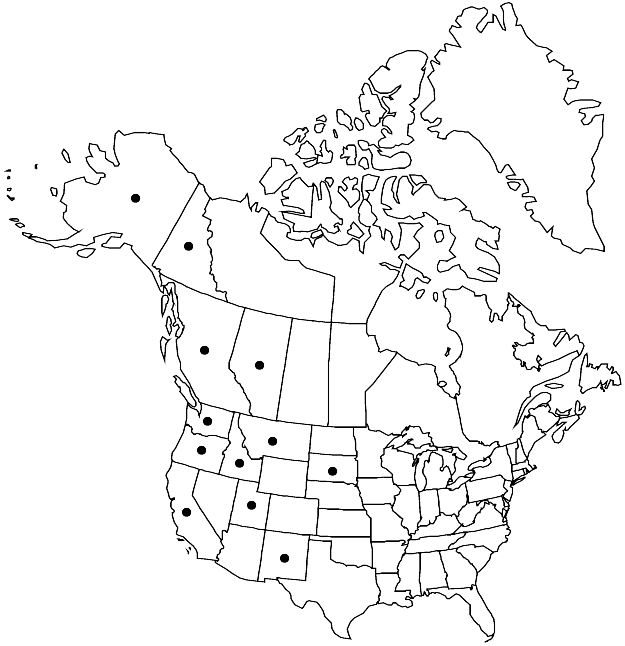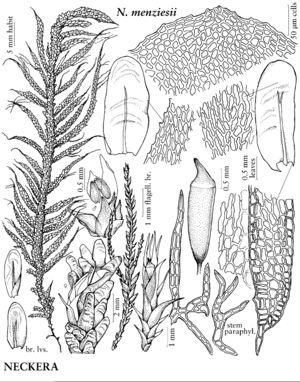Difference between revisions of "Neckera menziesii"
Musc. Amer., 162. 1828.
FNA>Volume Importer |
FNA>Volume Importer |
||
| Line 29: | Line 29: | ||
|elevation=low to high elevations (10-2000 m) | |elevation=low to high elevations (10-2000 m) | ||
|distribution=Alta.;B.C.;Yukon;Alaska;Calif.;Idaho;Mont.;N.Mex.;Oreg.;S.Dak.;Utah;Wash.;Europe;Asia (China;Japan). | |distribution=Alta.;B.C.;Yukon;Alaska;Calif.;Idaho;Mont.;N.Mex.;Oreg.;S.Dak.;Utah;Wash.;Europe;Asia (China;Japan). | ||
| − | |discussion=<p>Neckera menziesii can be distinguished from other dioicous species by the single costa that extends 3/4 of the leaf length and the slightly serrate leaf margin of straight teeth. In addition, the seta is very short, and the capsule immersed. The abundant paraphyllia and single costa were used by W. C. Steere (1941, 1967) to segregate N. menziesii into the genus Metaneckera. Those characters are common in other Neckera species from South and Central America and Asia and therefore within the limits of the genus. The stem leaf base is slightly auriculate; the margins are recurved basally; and the distal medial cell walls are pitted.</p> | + | |discussion=<p><i>Neckera menziesii</i> can be distinguished from other dioicous species by the single costa that extends 3/4 of the leaf length and the slightly serrate leaf margin of straight teeth. In addition, the seta is very short, and the capsule immersed. The abundant paraphyllia and single costa were used by W. C. Steere (1941, 1967) to segregate <i>N. menziesii</i> into the genus Metaneckera. Those characters are common in other <i>Neckera</i> species from South and Central America and Asia and therefore within the limits of the genus. The stem leaf base is slightly auriculate; the margins are recurved basally; and the distal medial cell walls are pitted.</p> |
|tables= | |tables= | ||
|references= | |references= | ||
| Line 52: | Line 52: | ||
|publication year=1828 | |publication year=1828 | ||
|special status=Selected by author to be illustrated | |special status=Selected by author to be illustrated | ||
| − | |source xml=https://jpend@bitbucket.org/aafc-mbb/fna-data-curation.git/src/ | + | |source xml=https://jpend@bitbucket.org/aafc-mbb/fna-data-curation.git/src/8f726806613d60c220dc4493de13607dd3150896/coarse_grained_fna_xml/V28/V28_947.xml |
|genus=Neckera | |genus=Neckera | ||
|species=Neckera menziesii | |species=Neckera menziesii | ||
Revision as of 17:09, 18 September 2019
Plants 4–11(–20) cm. Stems with branches common, attenuate; paraphyllia many. Stem leaves (central) oblong to oblong-ligulate, undulate, 3–6 × (1–)2.2–2.5 mm; margins slightly serrate to serrulate distally; apex obtuse to broadly acute; costa single, 3/4 leaf length; alar cells quadrate; basal laminal cells quadrate to short-rectangular, 30–54 × 5–6 µm; distal medial cells linear, 27–36 × 3–5 µm; apical cells rhomboidal, (8–)12–18 × 5–6 µm. Sexual condition dioicous. Seta 0.2–0.3 cm. Capsule immersed.
Habitat: Logs, trunks, shaded rock and cliffs, mixed conifer-hardwood, Abies, Quercus, Sequoia, and Thuja forests
Elevation: low to high elevations (10-2000 m)
Distribution

Alta., B.C., Yukon, Alaska, Calif., Idaho, Mont., N.Mex., Oreg., S.Dak., Utah, Wash., Europe, Asia (China, Japan).
Discussion
Neckera menziesii can be distinguished from other dioicous species by the single costa that extends 3/4 of the leaf length and the slightly serrate leaf margin of straight teeth. In addition, the seta is very short, and the capsule immersed. The abundant paraphyllia and single costa were used by W. C. Steere (1941, 1967) to segregate N. menziesii into the genus Metaneckera. Those characters are common in other Neckera species from South and Central America and Asia and therefore within the limits of the genus. The stem leaf base is slightly auriculate; the margins are recurved basally; and the distal medial cell walls are pitted.
Selected References
None.
